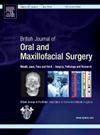Role of MSX1 in the development of non-syndromic clefts in the sub-Himalayan region of India
IF 1.9
4区 医学
Q3 DENTISTRY, ORAL SURGERY & MEDICINE
British Journal of Oral & Maxillofacial Surgery
Pub Date : 2025-07-01
DOI:10.1016/j.bjoms.2025.04.003
引用次数: 0
Abstract
Non-syndromic cleft lip and palate (NSCL/P) is a prevalent congenital anomaly influenced by genetic and environmental factors. The role of the MSX1 gene in NSCL/P has been explored in various populations, with conflicting results. This study investigates the association between MSX1 single nucleotide polymorphisms (SNPs) rs11726039 and rs3821949 and NSCL/P in a sub-Himalayan population of India. A total of 395 subjects, including 216 patients and 179 controls, were genotyped using TaqMan assays. The study also considered environmental factors, such as maternal smoking and folic acid intake. Statistical analysis, including odds ratios (OR), Fisher’s exact test, and Hardy-Weinberg equilibrium, was used to assess the association between the SNPs (single nuclear polymorphisms) and NSCL/P. While rs11726039 showed no significant association in either patient or parental samples, rs3821949 indicated a protective effect in fathers (OR = 0.44, p = 0.001) but not in patients. The findings highlight population-specific variations in the genetic aetiology of NSCL/P and the need for larger studies to confirm the role of MSX1 SNPs in the sub-Himalayan region. Despite being located in the same country, differences in genetic associations were noted between the sub-Himalayan and South Indian populations, underscoring the complexity of genetic interactions in NSCL/P.
MSX1在印度亚喜马拉雅地区非综合征性唇裂发展中的作用。
非综合征型唇腭裂(NSCL/P)是一种常见的先天性畸形,受遗传和环境因素的影响。MSX1基因在不同人群中NSCL/P中的作用已被探索,但结果相互矛盾。本研究调查了印度亚喜马拉雅人群MSX1单核苷酸多态性rs11726039和rs3821949与nsl /P之间的关系。共有395名受试者,包括216名患者和179名对照组,使用TaqMan检测进行基因分型。该研究还考虑了环境因素,如母亲吸烟和叶酸摄入量。统计分析,包括比值比(OR)、Fisher精确检验和Hardy-Weinberg平衡,用于评估snp(单核多态性)与NSCL/P之间的关系。rs11726039在患者和亲本样本中均无显著相关性,rs3821949在父亲中显示保护作用(or = 0.44, p = 0.001),但在患者中没有。这些发现强调了nsl /P遗传病因的人群特异性差异,以及需要进行更大规模的研究来确认MSX1 snp在喜马拉雅地区的作用。尽管位于同一个国家,但在喜马拉雅地区和南印度人群之间存在遗传关联的差异,强调了NSCL/P遗传相互作用的复杂性。
本文章由计算机程序翻译,如有差异,请以英文原文为准。
求助全文
约1分钟内获得全文
求助全文
来源期刊
CiteScore
3.60
自引率
16.70%
发文量
256
审稿时长
6 months
期刊介绍:
Journal of the British Association of Oral and Maxillofacial Surgeons:
• Leading articles on all aspects of surgery in the oro-facial and head and neck region
• One of the largest circulations of any international journal in this field
• Dedicated to enhancing surgical expertise.

 求助内容:
求助内容: 应助结果提醒方式:
应助结果提醒方式:


